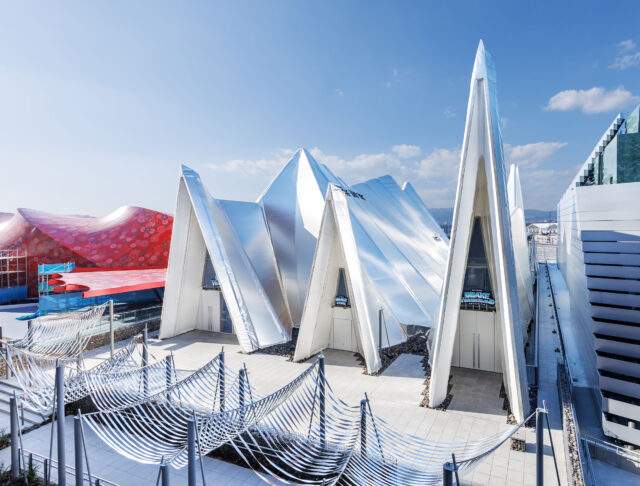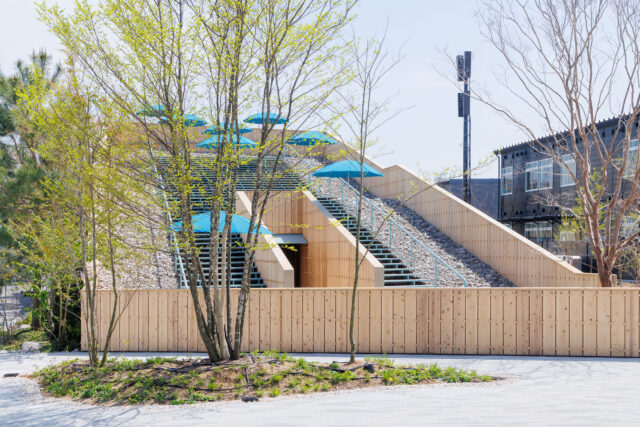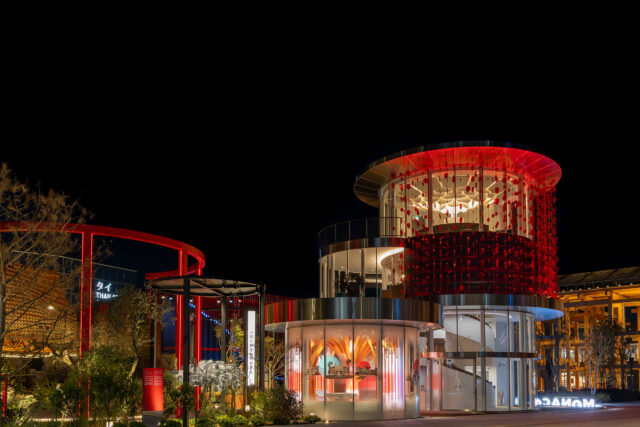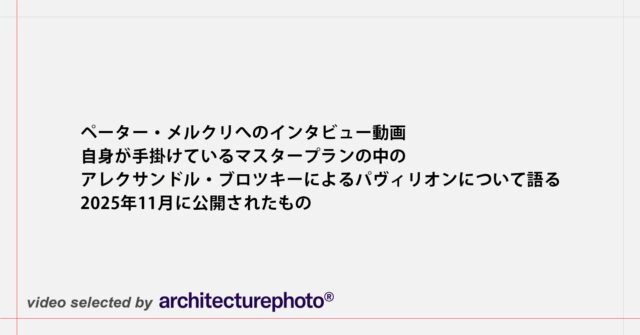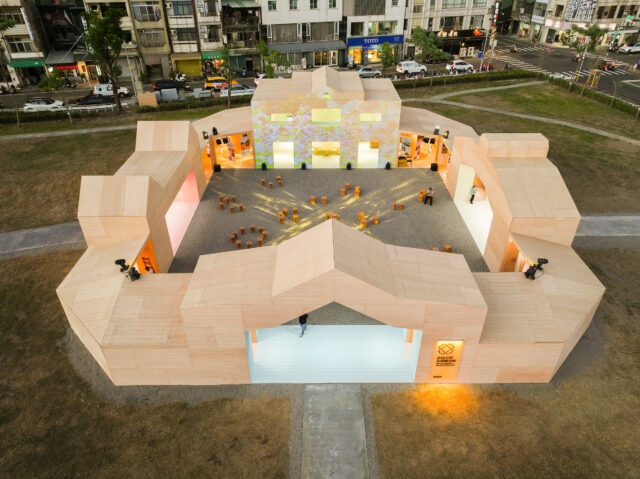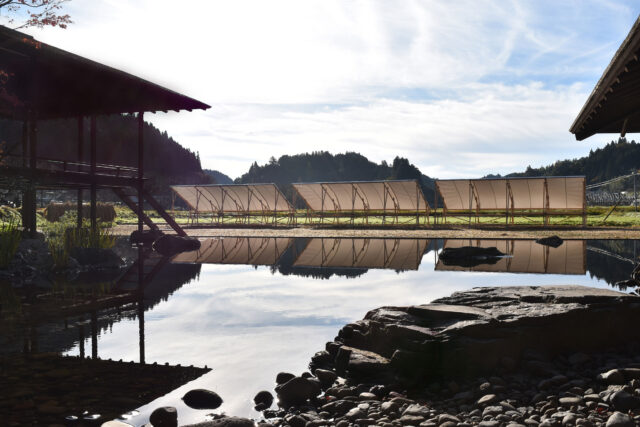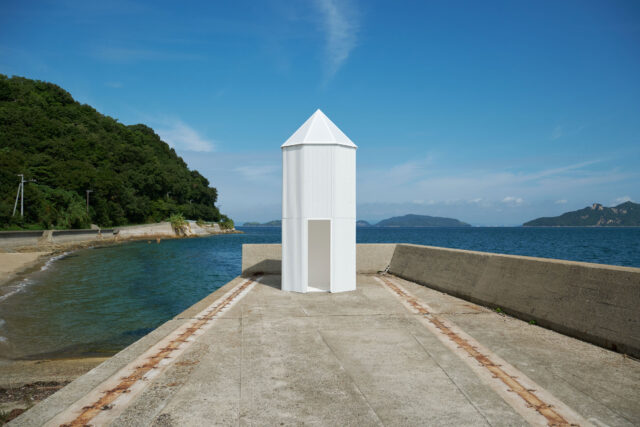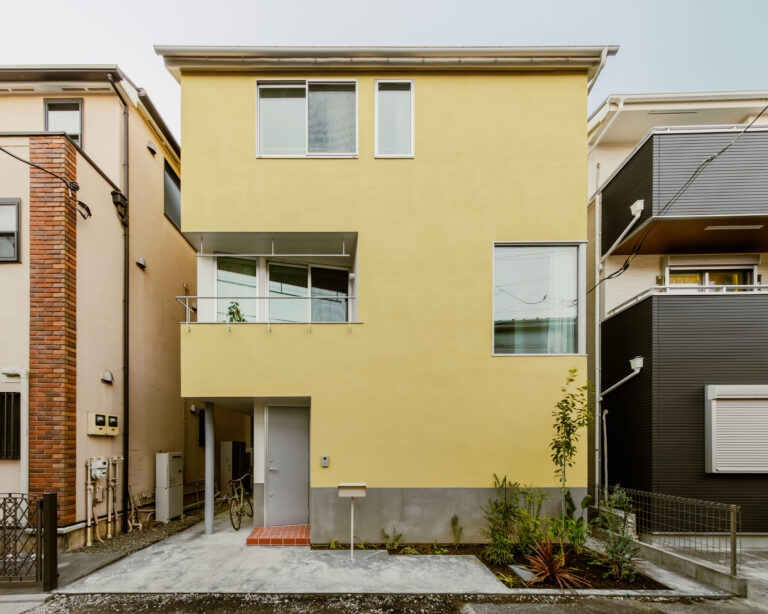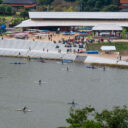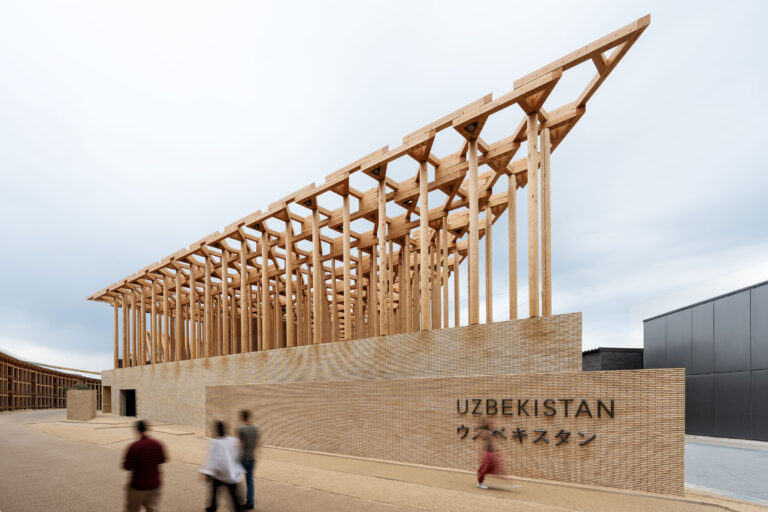
SHARE アトリエ・ブリュックナーによる、大阪・関西万博の「ウズベキスタンパビリオン」。“知の庭”をテーマとした施設。“木の下に集う”という発想から出発し、国の歴史的なモスクを参照して木柱が並ぶ“静かな森”を備えた建築を考案。持続可能性も考慮し材料の入手経路も公開する仕組も導入する




アトリエ・ブリュックナー(ATELIER BRUCKNER)による、大阪・関西万博の「ウズベキスタンパビリオン」です。
“知の庭”をテーマとした施設です。建築家は、“木の下に集う”という発想から出発し、国の歴史的なモスクを参照して木柱が並ぶ“静かな森”を備えた建築を考案しました。また、持続可能性も考慮し材料の入手経路も公開する仕組も導入しています。施設の公式ページはこちら。
こちらはリリーステキストの日本語版です(オフィシャルに公開されたもの)
ウズベキスタンパビリオン、伝統技能と国の持続可能な未来を紹介
・ウズベキスタンパビリオンの設計および一般展示は、そのテーマである「知の庭:未来社会の実験室」の精神を表現したものであり、ウズベキスタンの豊かな遺産が、持続可能な進歩・協力・革新に向けた確固たる土台であることを示しています。
・パビリオンの革新的なデザインは、持続可能な建築を基盤とし、自然素材やインタラクティブな展示、そしてウズベキスタンの歴史的建造物や文化遺産から着想を得つつ、現代の職人技を融合しています。
2025年4月10日、ウズベキスタン・タシケント – 2025年日本国際博覧会(以下、大阪・関西万博)のウズベキスタンパビリオンは、「知の庭:未来社会の実験室(Garden of Knowledge: A Laboratory for a Future Society)」と題した没入型の展示を行います。ウズベキスタン芸術文化開発財団(Uzbekistan Art and Culture Development Foundation: ACDF)の委託を受け、受賞歴を誇るドイツの建築設計会社 アトリエ・ブリュックナー(ATELIER BRUCKNER)が設計したパビリオンとその展示物は、今年開催される万博の総合テーマ「いのち輝く未来社会のデザイン」を反映しています。木彫りや寺院建築をはじめ、ウズベキスタンと日本は長い歴史を持つ芸術的伝統を共有しており、本パビリオンは両国間の有意義な文化交流を促進すると期待されています。
パビリオン内では、ウズベキスタンの「2030年戦略」およびユネスコの「持続可能な開発目標(SDGs)」に沿い、教育、文化、イノベーション、クリーンエネルギーの各分野における同国の変革を反映する主要事業が展示されています。まず1階では、再生可能エネルギーの取り組み、風力発電所、持続可能な交通機関を紹介する展示を通して、ユネスコのSDG 7 「エネルギーをみんなに、そしてクリーンに」に基づいたウズベキスタンのグリーン経済への移行をテーマに、ダイナミックなメディアインスタレーションを体験することができます。次に、産業開発エリアでは、SDG 9「産業と技術革新の基盤をつくろう」に対するウズベキスタンの取り組みが紹介されており、特に日本政府の支援によるアラル海地域再生イニシアティブを通じて、革新的な農業方法が歴史的に荒廃した同地域をいかに復活させているかに焦点が当てられています。さらに、パビリオンの文化発展エリアでは、SDG 4 「質の高い教育をみんなに」に関する進展が取り上げられており、国際的な「ホモ・ファーベル(人とものづくり)」プロジェクトが紹介されています。同プロジェクトは、天然素材と持続可能性を意識した熟練職人、若手クリエイター、デザイナーによるグローバルなコラボレーションを促進し、優れた職人技を称えるものです。
ウズベキスタン共和国大統領シャフカト・ミルジヨエフ氏のコメント:「いま、ウズベキスタンは豊かな遺産と無限の未来の可能性が交差する、大胆なビジョンを体現する歴史的な岐路に立っています。包括的な改革戦略のもと、我が国は持続可能な開発、グリーンエネルギー、デジタル化、人工知能を優先事項として前進を続けています。これらの変革を推進する原動力は、国民のエネルギー、野心、そして知識への飽くなき探求心です。2025年大阪・関西万博は、私たちのこれまでの歩み、成果とパイオニア精神を披露する場になるでしょう。今回のパビリオンは、ウズベキスタンの進歩・進化やグローバル・パートナーシップに対する真摯な取り組みを象徴するものです。」
「木の下に集う」というアイデアから着想を得たパビリオンの建築コンセプトは、かつてシルクロード沿いで営まれていた隊商宿(キャラバンサライ)を彷彿とさせます。隊商宿は、歴史的に旅人や商人たちの休息場所となっていました。こうした伝統に基づく保護・教育・知識交換の原則を再解釈することで、パビリオンでは現代的で持続可能な「知の庭」を作り上げました。2025年大阪万博の西入口近くに位置するこのパビリオンは、来場者が足を踏み入れた瞬間からウズベキスタンの豊かな伝統と現代的な革新に触れることができるように、開放的で魅力的な空間として設計されています。
ウズベキスタン芸術文化発展財団(ACDF)の会長兼ウズベキスタンパビリオンのコミッショナーを務めるガヤネ・ウメロワ氏のコメント: 「2025年大阪万博のウズベキスタンパビリオンは、単なる建築上の功績にとどまらず、イノベーション、持続可能性、グローバル・コラボレーションに対する我が国の献身を力強く表明するものです。ウズベキスタンの文化遺産に深く根ざし、未来を鋭く見据えたパビリオンは、対話、知識の共有、創造的パートナーシップのためのダイナミックなプラットフォームとして機能します。ウズベキスタンは、日本との長年の友好関係からも明らかなように、文化交流の強さを常に信じてきました。2025年大阪万博に参加することで、私たちはさらに強いグローバルなつながりを構築する構えがあることを誇りをもって再び強調します。私たちは共に、より持続可能で相互接続された世界のための永続的な解決策を鼓舞する有意義な対話を推進していきます」
展示のハイライトは、上昇するプラットフォーム内における 360度のマルチメディアの旅です。わずか3分強の間に、プロジェクションとサウンドスケープが来場者をウズベキスタンの変容に没入させ、「知の庭」への到着を準備させます。この動くプラットフォームは、デザインや機能的にもユニークなもので、日本ではこれまで見られたことがない内容です。
来場者が「知の庭」の吹き抜けテラスに上ると、ヒヴァに残る歴史的なジュマ・モスクへの建築的なオマージュである細い木製の柱が林立する静かな森に入ります。パビリオンの持続可能性を強化し、材料の入手経路について情報公開するために、各柱には近距離無線通信(NFC)タグが取り付けられており、パビリオンの建設に使用された日本産木材の原産地を来場者が追跡できるようになっています。また、日本生まれのレバノン人デザイナー、ナダ・デブス氏(Nada Debs)が制作した手作りの陶器製スツールは、ウズベキスタンの伝統工芸からインスピレーションを得たものです。さらに、ウズベキスタンの陶芸家であり「ホモ・ファーベル」プロジェクトの卒業生でもあるアブドゥルバヒド・ブホリイ・カリモフ氏 (Abdulvahid Bukhoriy Karimov)は、パビリオンの床、壁、天井に使用するために、ターコイズブルーの伝統的なブハラタイルを11,000枚以上制作しました。パビリオンのデザインと内装装飾に貢献した他のウズベキスタン人アーティストには、スザニ刺繍作家のマディナ・カスィムバエワ氏(Madina Kasymbaeva)と陶芸家のアリシェル・ナジロフ(Alisher Nazirov)がいます。
2025年4月13日に一般公開されるウズベキスタンパビリオンでは、2025年大阪万博の会期6か月間を通して、魅力的な文化イベント、ディスカッション、パフォーマンスが催されます。また、5月には特別イベントとして、万博ホールでウズベキスタン国立交響楽団とリクター・トリオ(Richter Trio)によるコンサートが行われます。さらに、来場者は「テーマウィーク」やカルティエによる「ウーマンズ パビリオン(Women’s Pavilion)」で開催される、持続可能性、生物多様性、芸術に関するセッションにもご参加いただけます。そして9月には、ウズベキスタン共和国のナショナルデーを祝うイベントも開催予定です。なお一般公開プログラムの詳細は、追ってお知らせいたします。
アトリエ・ブリュックナーの創設パートナー兼マネージングディレクターである、シリン・フランゴール=ブリュックナー氏のコメント: 「私たちはウズベキスタンのアイデンティティを、好奇心、つながり、そして共有すべき未来を刺激する空間として表現できたことを誇りに思います。ウズベキスタンパビリオンは、単なる建造物ではありません。それは、並外れた発展の可能性を秘めた国家の象徴なのです。豊かな文化と建築の遺産に根ざし、変容する伝統の物語を伝えつつ、このパビリオンで私たちは、交流、革新、持続可能性の精神を称えます。歴史的な形態と素材は、現代的なデザインによって再解釈され、時代を超えた先進性を感じさせる体験を生み出しています。ACDFとともにこうしたビジョンを実現できたことを心より光栄に思います」
デザイナーであるナダ・デブス氏のコメント: 「日本で育ち、シルクロードの伝統に深く影響を受けた私にとって、今回のプロジェクトは特別な意味を持っています。アラブ地域在住のデザイナーとして、私の作品では文化的な影響と職人技の知識交換が相互に作用することが多いのです。ウズベキスタンパビリオンのVIPルームと陶器のスツールのデザインは、伝統工芸の再解釈にとどまらず、文化間の活気あふれる対話を表現しており、これまでにない形でウズベキスタンの新たな目標とビジョンを創出するものです。私はこの文化交流に貢献し、新たな遺産の創出に携わることができたことをこの上なく誇りに思っています」
陶芸家であるアブドゥルバヒド・ブホリイ・カリモフ氏のコメント: 「このプロジェクトの一端を担えることを心より誇りに思います。1992年より私は、陶芸に使用されるブハラの伝統的なゆう薬を再現することを夢見てきました。そして、ACDFとユネスコの支援により、2006年に工房を設立することができました。これを礎に、尊敬する陶芸家たちが何世紀にもわたって受け継いできた調合法を復活させることができました。今後も私は、自分の作品を通じて彼らの遺産を称え続けていきたいと思います」。
ウズベキスタンパビリオンは、2025年4月13日から10月13日まで、大阪の夢洲島で開催される大阪・関西万博で公開されます。
2025年大阪万博 ウズベキスタンパビリオン「知の庭:未来社会の実験室」はウズベキスタン芸術文化開発財団(ACDF)によって委託されました: https://www.expo2025uzbekistan.uz/
以下の写真はクリックで拡大します










以下、リリーステキストです。
Uzbekistan Pavilion at Expo 2025 Osaka brings Heritage Craftsmanship and the Country’s Sustainable Future to Life
・The Pavilion’s innovative design is rooted in sustainable architecture, combining natural materials, interactive installations, and contemporary craftsmanship inspired by historic Uzbek landmarks and cultural heritage.
・The Uzbekistan Pavilion’s design and public programme brings to life the spirit of the Garden of Knowledge: A Laboratory for a Future Society, demonstrating how Uzbekistan’s rich heritage provides fertile ground for sustainable progress, collaboration and innovation.
Tashkent, Uzbekistan, 10 April 2025 – The Uzbekistan Pavilion at Expo 2025 Osaka will present an immersive showcase entitled Garden of Knowledge: A Laboratory for a Future Society. Commissioned by the Uzbekistan Art and Culture Development Foundation (ACDF) and designed by award-winning ATELIER BRUCKNER, the Pavilion and its exhibition echoes the overarching theme of this year’s expo – Designing Future Societies for our Lives. As Uzbekistan and Japan share long-standing artistic traditions such as wood carving and temple construction, the Pavilion fosters meaningful cultural dialogue between the two countries.
Inside the pavilion, the exhibition highlights key projects that reflect Uzbekistan’s transformation in the areas of education, culture, innovation, and clean energy, aligned with the country’s Strategy 2030 and UNESCO development goals. On the ground floor, guests can explore dynamic media installations highlighting Uzbekistan’s transition to a green economy, aligning with UNESCO’s Sustainable Development Goal (SDG) 7 (Affordable and Clean Energy) through exhibits showcasing renewable energy initiatives, wind farms, and sustainable transport. The Industrial Development area illustrates Uzbekistan’s commitment to SDG 9 (Industry, Innovation and Infrastructure), notably through the Aral Sea Basin restoration initiative, supported by the Japanese government, demonstrating how innovative farming methods are reviving this historically devastated region. Additionally, the country’s advancement of the SDG 4 (Quality Education) is featured in the Cultural Development section of the Pavilion with the international Homo Faber project, a celebration of craftsmanship excellence fostering global collaborations among master artisans, young creators, and designers working sustainably with natural materials.
President of the Republic of Uzbekistan Shavkat Mirziyoyev said: “Today, Uzbekistan stands at a historic crossroads, embodying a bold vision for the future where our rich heritage meets the boundless opportunities of tomorrow. Guided by a comprehensive reform strategy, our country is confidently moving forward – prioritizing sustainable development, green energy, digitalization, and artificial intelligence. The driving force behind these transformations is the energy, ambition, and insatiable thirst for knowledge of our people. The National Pavilion of Uzbekistan at Expo 2025 Osaka will reflect this journey, showcasing our achievements and the innovative spirit of our nation. It is a symbol of Uzbekistan’s commitment to progress and global partnership.”
Inspired by the idea of gathering under trees, the Pavilion’s architectural concept evokes ancient caravanserais along the Silk Road: places that historically provided shelter for travellers and traders. By reinterpreting traditional principles of protection, education, and knowledge exchange, the Pavilion becomes a contemporary and sustainable Garden of Knowledge. Located near the West Entrance of Expo 2025 Osaka, it is designed as an open and inviting space, where guests engage with Uzbekistan’s rich heritage and contemporary innovation from the moment they arrive.
Chairperson of the Uzbekistan Art and Culture Development Foundation and Commissioner of the Pavilion Gayane Umerova says: “The Uzbekistan Pavilion at Expo 2025 Osaka is not just an architectural landmark: it is a powerful statement of our nation’s commitment to innovation, sustainability, and global collaboration. Deeply rooted in our cultural heritage and sharply focused on the future, the Pavilion serves as a dynamic platform for dialogue, knowledge-sharing, and creative partnership. Uzbekistan has always believed in the strength of cultural exchange, as evidenced by our longstanding friendship with Japan. By participating in Expo 2025 Osaka, we proudly reaffirm our readiness to build even stronger global connections. Together, we will drive meaningful conversations that inspire lasting solutions for a more sustainable, interconnected world.”
The highlight of the exhibition is a 360-degree multimedia journey inside a rising platform. In just over three minutes, projections and soundscapes immerse guests in Uzbekistan’s transformation, preparing them for their arrival in the Garden of Knowledge above. Unique in both its innovative design and purpose, this moving platform is the first of its kind in Japan, offering an unprecedented visitor journey.
As viewers ascend to the Garden of Knowledge open roof terrace, they enter a serene forest of slender wooden columns, an architectural tribute to the historic Juma Mosque in Khiva. Reinforcing the Pavilion’s commitment to sustainability and material transparency, columns are equipped with NFC tags that allow viewers to trace the Japanese origin of the timber used in the Pavilion’s construction.
Shirin Frangoul-Bruckner, Founding Partner and Managing Director of Atelier Bruckner, says: “We are deeply proud to have translated Uzbekistan’s identity into a space that inspires curiosity, connection, and a shared future. The Uzbekistan Pavilion is far more than a structure – it is a powerful symbol of a nation with extraordinary development potential. Rooted in a rich cultural and architectural heritage, it tells a story of tradition in transformation. With this pavilion, we celebrate the spirit of exchange, innovation, and sustainability. Historic forms and materials were reimagined through contemporary design to create an experience that feels both timeless and forward-looking. It was a true honour to bring this vision to life together with ACDF.”
Handcrafted ceramic stools designed by Japan-born, Lebanese Nada Debs in collaboration with Uzbek artisans, are inspired by traditional Uzbek craftsmanship. Debs has also contributed to the furniture and design of the VIP room of the Pavilion. Uzbek ceramicist Abdulvahid Bukhoriy Karimov created more than 11,000 traditional Bukharian tiles in the signature turquoise colour for the floor, walls and ceiling of the Pavilion shop. Other Uzbek artists who contributed to the Pavilion design and interior decoration, are suzani embroiderer Madina Kasymbaeva and ceramicist Alisher Nazirov.
Designer Nada Debs says: “Raised in Japan and deeply influenced by the heritage of the Silk Route, this project holds a special place in my heart. As a designer residing in the Arab region, my work often revolves around the interplay of cultural influences and the exchange of artisanal knowledge. The design of the Uzbekistan Pavilion VIP room and our ceramic stools represents not just a reinterpretation of traditional crafts, but a vibrant dialogue between cultures, pushing boundaries to forge new objects and visions for Uzbekistan. I am immensely proud to contribute to this cultural exchange and to be part of crafting a new legacy.”
Ceramicist Abdulvahid Bukhoriy Karimov says: “My heart is filled with pride for being a part of this project. From 1992 I’ve been dreaming about recreating traditional Bukhara glazes, and with the support of ACDF and UNESCO I was able to set my studio up in 2006. I then was able to revive the centuries-old recipes of our esteemed ceramicists, and I continue to celebrate their heritage in my work”.
Opening to the public on 13 April 2025, the Uzbekistan Pavilion will offer an engaging programme of cultural events, discussions, and performances spanning the six-month duration of the Expo 2025 Osaka. In May the Pavilion will host a special event at the Expo Hall featuring a concert by the National Symphony Orchestra of Uzbekistan with the participation of the Richter Trio. Additionally, visitors will be able to join sessions on sustainability, biodiversity, and the arts, held within the Theme Weeks and the Women’s Pavilion by Cartier. September will see a celebration of the National Day of the Republic of Uzbekistan. Further details on the public programme will be announced in due course.
The Uzbekistan Pavilion at Expo 2025 is open from April 13 to October 13, 2025, on Yumeshima Island in Osaka, Japan.
Garden of Knowledge: A Laboratory for a Future Society in the Uzbekistan Pavilion for Expo 2025 Osaka, commissioned by the Uzbekistan Art and Culture Development Foundation (ACDF): https://www.expo2025uzbekistan.uz/
■建築概要
Client: Uzbekistan Art and Culture Development Foundation
Architects: ATELIER BRUCKNER
Scenography: ATELIER BRUCKNER
Constultant Structural Engineering: Werner Sobek AG
Contractor: Nussli Group
Local Architect: Tokuoka Sekkei





